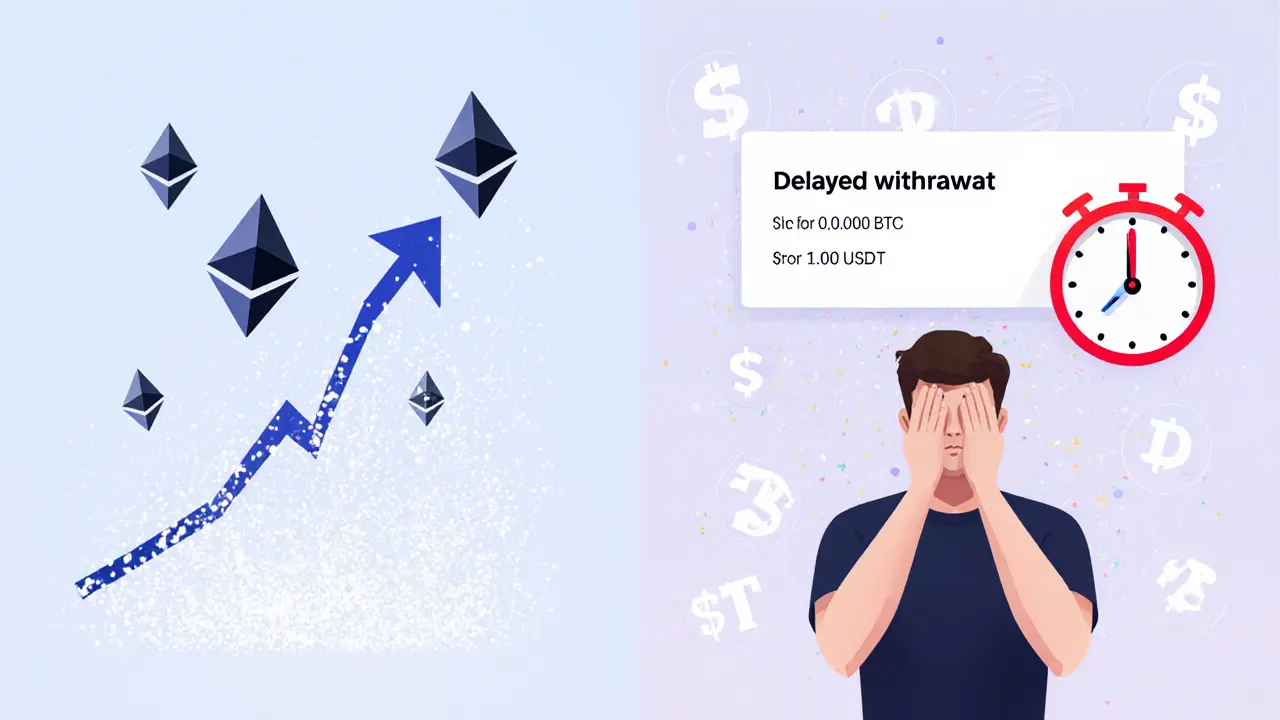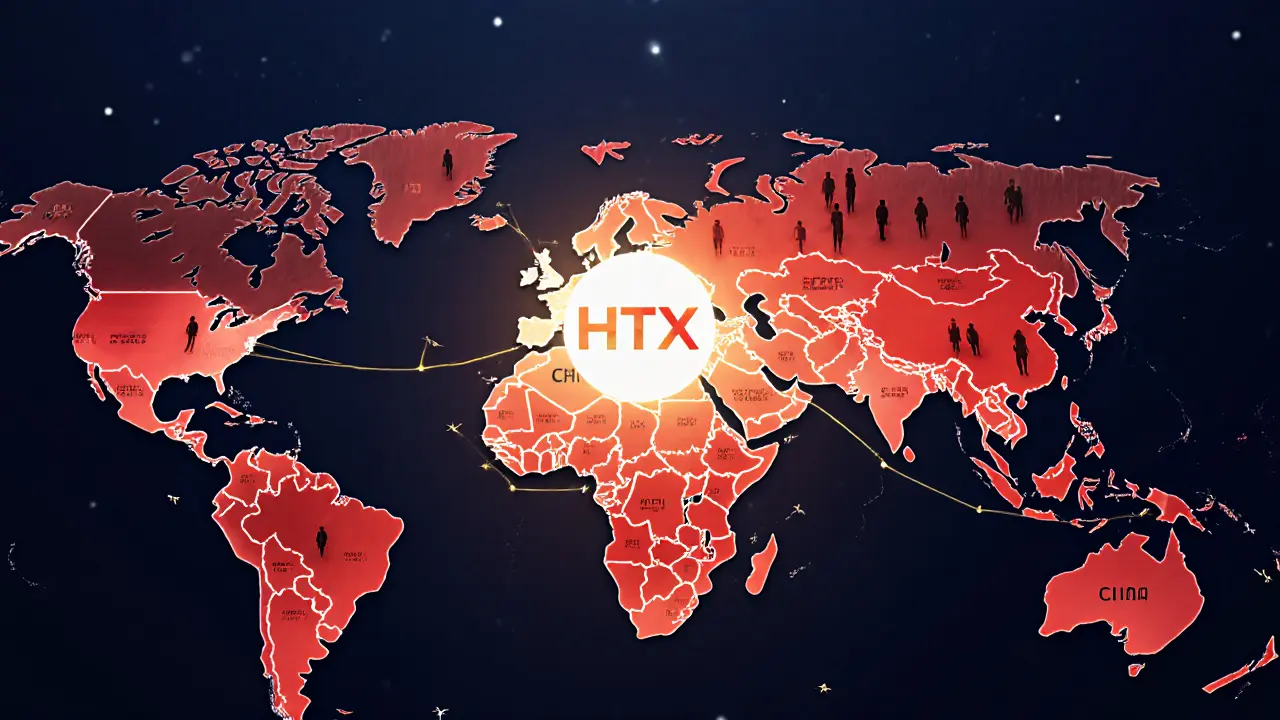HTX Crypto Exchange Review: Features, Fees, and Real User Experience in 2025
 Nov, 6 2025
Nov, 6 2025
HTX Withdrawal Fee Calculator
Withdrawal Fee Estimator
When you're looking for a crypto exchange that offers more than just Bitcoin and Ethereum, HTX stands out - but is it right for you? Launched in 2013 as Huobi and rebranded to HTX in 2023, this exchange has grown into one of the world’s largest platforms, serving over 50 million users and managing more than $6.4 billion in assets. It’s not just another exchange. HTX pushes into new territory with DAO governance, 700+ cryptocurrencies, and 200x leverage trading. But behind the numbers, real users report mixed experiences - fast withdrawals for some, frustrating delays for others. Let’s cut through the hype and see what HTX actually delivers in 2025.
What HTX Offers: More Than Just Trading
HTX isn’t just a place to buy and sell crypto. It’s a full ecosystem. You can trade spot pairs, bet on futures with up to 200x leverage, stake your coins for passive income, trade NFTs, and even use automated trading bots. The platform integrates TradingView directly into its interface, so advanced traders get professional charting tools without switching apps. For those who want to earn without trading, HTX offers dual-reward staking, node staking, and lending options. If you’re into DeFi, HTX’s ecosystem gives you access to yield opportunities across multiple blockchains without leaving the app.
One of the biggest draws is the asset selection. With over 700 cryptocurrencies available, HTX supports everything from major coins like Bitcoin and Solana to obscure altcoins you won’t find on Coinbase or Kraken. If you’re trading niche tokens, HTX is one of the few places where you won’t need to hop between five different exchanges.
Fees: Low for Pros, High for Casual Users
HTX’s fee structure favors active traders. Spot trading fees are flat at 0.2% for both makers and takers. That’s standard - not the cheapest, but not the worst. Where HTX shines is in futures trading: makers pay just 0.02%, and takers pay 0.05%. That’s half the rate of many competitors. If you’re scalping or trading futures daily, HTX saves you money.
But here’s the catch: if you’re not trading often, the fees hurt. Withdrawal fees vary wildly by coin. Withdrawing 0.001 BTC might cost you $5, while withdrawing 100 USDT could cost $1. There’s no flat fee structure. Users report being shocked by unexpected withdrawal costs, especially when moving small amounts. P2P trading is fee-free, which is great if you’re buying crypto with bank transfers or cash, but that’s not an option for everyone.
HTX also doesn’t charge fees for deposits - crypto or fiat. That’s a plus. But if you’re using a credit card to buy crypto, you’ll pay third-party processor fees, which can be steep.
Security: Solid Infrastructure, Questionable Past
HTX uses a multi-tier cold storage system, multi-factor authentication, and proof of reserves to back its claims of security. In 2025, they published their reserve audit report - the first time they’ve done so publicly. It showed they hold 107% of user assets in reserve, meaning they’re not lending out your crypto to cover withdrawals. That’s a good sign.
But the past can’t be ignored. Huobi, HTX’s former name, was involved in a major hack in 2018 that lost $12 million. While the company reimbursed users, it damaged trust. Since then, they’ve rebuilt their security model, but some users still hesitate. The rebranding to HTX was partly about distancing from that history - and it worked, at least on paper. If you’re risk-averse, you might still prefer exchanges with cleaner track records like Kraken or Coinbase.

Verification and KYC: A Major Pain Point
HTX has three verification levels: L1 (basic), L2 (standard), and L3 (advanced). L1 lets you trade up to $10,000 per day with just an email and phone number. L2 requires ID and a selfie. L3 unlocks higher limits and futures trading - but it’s where things get messy.
Users consistently complain that the L3 verification process is slow and confusing. You might upload documents, get a request for a second photo, then be asked to record a video of yourself reading a code. One user in Perth reported waiting 11 days for approval - and that was after resubmitting three times. Customer support often replies with templated messages, not real help.
Compare that to Binance or Kraken, where verification takes 2-48 hours. HTX’s process feels outdated, especially for a platform that markets itself as modern and user-friendly. If you’re not planning to trade large amounts, you might skip L3 - but you’ll miss out on the best features.
Customer Support: Available, But Not Helpful
HTX offers 24/7 live chat and email support. That sounds good - until you try it. Many users report long wait times, especially during market spikes. Responses are often generic: “We’ve reviewed your case” or “Please check our help center.” There’s no phone support. No escalation path. If you’re locked out of your account or have a withdrawal issue, you’re stuck in a loop.
Compare that to Coinbase, where you can sometimes get a human on the phone within minutes. Or Kraken, where support agents actually explain what’s happening. HTX’s support feels like an afterthought. For a platform with 50 million users, that’s a red flag.

Who Is HTX For? And Who Should Avoid It?
HTX is perfect for experienced traders who want:
- Access to 700+ cryptocurrencies
- Low futures trading fees
- Advanced charting with TradingView
- Staking and passive income options
- DAO governance participation
If you’re a beginner, casual trader, or someone who just wants to buy Bitcoin and hold it, HTX isn’t the best fit. The interface is cluttered. The verification is a hassle. The support is unreliable. You’re better off with Coinbase or Kraken for simplicity.
Also, HTX is blocked in the U.S., China, Singapore, Hong Kong, and several other countries. If you’re in one of those places, you can’t legally use it. Even if you use a VPN, your account could be frozen.
The Bottom Line: Powerful, But Not Polished
HTX is a powerhouse in terms of features and asset selection. It’s growing fast - 92% user growth in the first half of 2025, top spot in spot trading volume. The tech is solid. The fees are competitive for active traders. The DAO governance model is innovative.
But it’s also clunky. The verification process is broken. Support is robotic. Withdrawal fees are unpredictable. For users who don’t trade daily, the friction outweighs the benefits.
If you’re a serious trader who needs deep liquidity, advanced tools, and access to obscure tokens - HTX is worth your time. But if you’re just starting out, or you value clean UX and reliable support, look elsewhere. HTX isn’t broken - it’s just unfinished. They’ve built the engine, but the cabin still needs a lot of work.
Is HTX safe to use in 2025?
HTX has improved its security significantly since its 2018 hack. It now uses multi-tier cold storage, proof of reserves, and mandatory 2FA. In 2025, they published a public audit showing they hold more than 100% of user assets in reserve. While the platform is technically secure, its past breaches and lack of regulatory licensing in major markets make it riskier than Coinbase or Kraken. Only use HTX if you understand the trade-offs.
Can I use HTX in the United States?
No. HTX is blocked in the United States due to regulatory restrictions. Even if you use a VPN to access the site, your account may be flagged, frozen, or permanently banned. The platform does not offer fiat on-ramps for U.S. users, and it does not comply with U.S. financial regulations. If you’re in the U.S., choose a licensed exchange like Coinbase, Kraken, or Gemini.
What are the withdrawal fees on HTX?
Withdrawal fees vary by cryptocurrency. For example, withdrawing Bitcoin might cost 0.0005 BTC ($30+), while withdrawing USDT costs 1 USDT. There’s no flat fee structure. HTX doesn’t charge for deposits, but you’ll pay third-party fees if you buy crypto with a credit card. Always check the withdrawal fee before sending funds - it’s not always obvious until you start the process.
Does HTX offer staking rewards?
Yes. HTX offers staking for over 100 Proof of Stake coins, including Ethereum, Solana, Cardano, and Polkadot. Rewards are paid daily, and APYs range from 2% to 15% depending on the asset. They also offer dual-reward staking, where you earn both crypto rewards and platform tokens. Staking is easy to set up, but funds are locked for a period - usually 1-30 days. Withdrawals are processed automatically after the lock-up ends.
How does HTX compare to Binance?
HTX and Binance are similar in asset selection and trading volume, but Binance has better fiat on-ramps, lower withdrawal fees for most coins, and superior customer support. Binance also offers more educational content and a smoother beginner experience. HTX’s edge is its DAO governance model and slightly lower futures fees. If you’re in a region where Binance is restricted, HTX is a strong alternative - but if you can use Binance, it’s the more polished platform.


Louise Watson
November 8, 2025 AT 04:54Benjamin Jackson
November 9, 2025 AT 13:08Liam Workman
November 11, 2025 AT 11:09Leo Lanham
November 12, 2025 AT 09:02Brian Webb
November 13, 2025 AT 13:27Whitney Fleras
November 13, 2025 AT 15:12Colin Byrne
November 13, 2025 AT 17:53Sarah Scheerlinck
November 15, 2025 AT 14:31Evan Koehne
November 15, 2025 AT 21:49Vipul dhingra
November 17, 2025 AT 01:06Jacque Hustead
November 17, 2025 AT 21:31Jeana Albert
November 18, 2025 AT 02:56Diana Smarandache
November 20, 2025 AT 02:43Liam Workman
November 20, 2025 AT 06:31